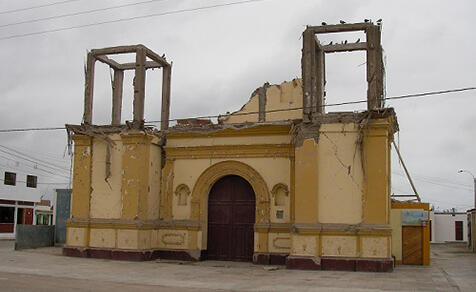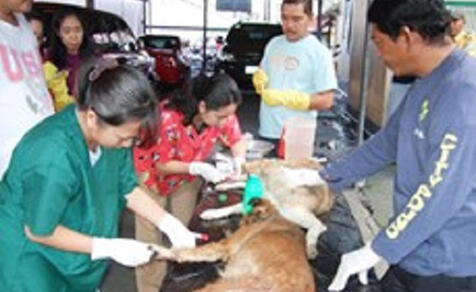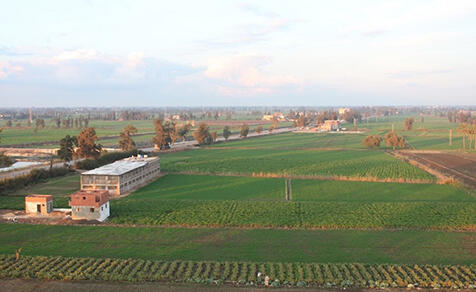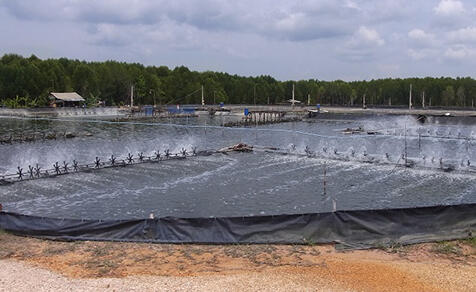Investigating the silent seeds of disaster in two lakes - Saving lives from disasters caused by CO2 -
Investigating the silent seeds of disaster in two lakes
- Saving lives from disasters caused by CO2 -
Research Fields and Areas
Disaster Prevention and Mitigation

The Republic of Cameroon is home to a chain of volcanoes called the Cameroon Volcanic Line that stretches a total of 1,600 km. Two disasters occurred in this volcanic line in the 1980s. Huge amounts of CO2 suddenly exploded from Lake Monoun and Lake Nyos, which are crater lakes--lakes that form over volcanic craters--and flowed down valleys into nearby villages, causing many deaths from lack of oxygen.
Water containing CO2 issues from the bottom of Lake Monoun and Lake Nyos. Carbon dioxide dissolves in the lakes, where it accumulates. Triggered by some event, it rapidly gasifies and erupts from the surface of the lake. The phenomenon is called "limnic eruption" due to the violence of the event. This project aims to protect precious human life from disasters caused by such eruptions of CO2. It studies conditions in which limnic eruptions occur, and develops equipment that can pump water containing large amounts of CO2 up from the bottom of the lakes.




Principal Investigator (Japan):Professor OHBA Takeshi
School of Science, Tokai University
He received his Doctor of Science degree from Graduate School of Science and Engineering of Tokyo Institute of Technology. He later worked as research associate and associate professor at Tokyo Institute of Technology's Volcanic Fluid Research Center until assuming his current position in 2010.
 Japan perspective
Japan perspective
Preventing volcanic gas disasters
Apart from the direct harm caused by volcanic eruptions, population of the vicinity of volcanoes, and mountain climbers, have suffered the effects of volcanic gas. With the disasters at Lake Monoun and Lake Nyos being the largest gas disasters, it is the mission of all the volcanologists to determine the cause and look for a solution. No lakes in Japan are accumulating CO2, but the fact that Lake Monoun and Lake Nyos were formed as the result of phreatomagmatic eruptions, and that this is related to systems that supply CO2, is significant, and merits scholarly research.
Principal Investigator (Cameroon):Dr. Joseph Victor Hell
Director, Institute of Geological and Mining Research
 Cameroon's perspective
Cameroon's perspective
Establishing observation systems for preventing limnic eruptions
The lifespan of magma lying in the earth under Lake Monoun and Lake Nyos is thought to be over 10,000 years. We must accept that the magma will continue to emit CO2 gas on a perpetual basis. Currently, the amount of CO2 accumulation in both lakes is at a safe, low level, but there is a high likelihood that CO2 will accumulate. Equipment is needed in order to monitor the lakes, and skilled staff is required in order to make full use of that equipment. Thanks to SATREPS, both of these are now available. We are very grateful for this assistance.
Project outcomes
Monitoring the state of the lakes
Water with a high CO2 content is discharging from the lake beds, but the amount of water is variable. Consequently, it is necessary to constantly monitor the lakes, and see if anomalies are occurring. To this end, an automatic observation buoy was installed in Lake Nyos. Data from the buoy is transmitted to researchers via satellite and this makes it possible to detect anomalies in real time.

Reducing CO2 accumulations by pumping up water from the lake bed
In order to prevent CO2 from accumulating, we installed solar-powered equipment at Lake Monoun that releases CO2 by pumping water up from the depths of the lake. Lake Nyos and Lake Monoun had simple systems before, but this new equipment has much greater capacity for releasing CO2.

Major outcome achieved by studying lake bed
AAs a result of probing the geography of the lake bed with ultrasound, we succeeded in identifying two locations in Lake Monoun that spew water containing large amounts of CO2. We anticipate that this will allow us to remove CO2 efficiently.
Simulating limnic eruptions
It was clear that CO2 was the cause of limnic eruptions, but we didn't understand the mechanism that brought it about. We conducted simulations based on various data, and verified the conditions under which limnic eruptions occur. As a result, we succeeded in finding the critical conditions that cause limnic eruptions, which greatly contributed to evaluating the safety of the lakes.

The area around Lake Nyos and Lake Monoun is currently sealed off, which is detrimental to agriculture and to the economy. Residents around the lakes are suffering as they had to leave their homes and land. If this project succeeds, and the safety of Lake Nyos and Lake Monoun can be guaranteed, many people will be able to return to their normal lives.



 Prof.OHBA
Prof.OHBA
There's no chance of a limnic eruption occurring in a Japanese lake. Japan has a climate with clearly defined seasons. As the weather becomes colder from autumn to winter, water near the surface of the lake is cooled, becoming heavier, and sinks to the bottom. This stirs the water in the lake. Even if CO2 did temporarily accumulate at the bottom of the lake, it would be brought up to the surface by the circulation of water in the lake, preventing a buildup. After the limnic eruption of Lake Nyos, lakes in Japan were studied, and it was confirmed that none had a buildup of CO2.

Will it exacerbate global warming?
 Prof.OHBA
Prof.OHBA
The amount of CO2 emitted from Lake Nyos and Lake Monoun every year is 50,000 tons. While that may sound like a lot, humans are releasing over six billion tons of CO2 every year from the burning of fossil fuels. By comparison, the lakes' emissions are only 1/100,000 of that, so they do not emit enough to significantly exacerbate global warming.

Where is it coming from?
 Prof.OHBA
Prof.OHBA
There is magma in the earth under Lake Nyos and Lake Monoun. We're not sure of the depth, but we think it lies over 30 km down. Although the magma is still, it is continually emitting CO2 gas. That's what magma does. The CO2 gas from the magma rises through cracks in the earth, and dissolves in groundwater. This groundwater then comes up from the bottom of Lake Nyos and Lake Monoun.

 Prof.OHBA
Prof.OHBA
A steel wire hangs from the automatic observation buoy, carrying sensors for water temperature and electrical conductivity. Electrical conductivity is the ease with which electricity passes through a medium, like water. The water temperature rises as CO2 levels increase, because the groundwater that brings the CO2 is warm. As CO2 increases, it reacts with H2O, resulting in H+ and HCO3- ions. And because electrical conductivity rises as the concentration of these ions increases, we can detect when the amount of CO2 dissolved in the lake changes.

 Prof.OHBA
Prof.OHBA
The CO2 dissolved in the lakes is measured using the following methods. One method uses a metal data logger device called a CTD, lowered into the lake on a cable to automatically measure water temperature, pH, and electrical conductivity. Another method involves filling a plastic syringe with an alkaline solution, lowering it into the water and mixing it with lake water by pulling a piston. We then pull it up and analyze the content in the laboratory. We combine these two methods to determine accurate and reliable CO2 concentration levels.

 Prof.OHBA
Prof.OHBA
Hydrothermal vents issuing geothermally heated water containing CO2 have been found at Lake Monoun, but so far not at Lake Nyos. In the future, we would like to find hydrothermal vents at Lake Nyos by conducting more detailed studies with methods that make use of ultrasound.

Lake Nyos and Lake Monoun lie in a volcanic field, but the volcanoes don't protrude above the surface unlike Mt. Fuji. So, why are they still called volcanoes? The answer is that Lake Nyos and Lake Monoun are maars, which are volcanic craters, rather than mountains. A maar forms when magma rising from deep within the earth encounters groundwater. When this happens, hot magma comes into contact with groundwater, resulting in what's called a phreatomagmatic eruption. This causes a large, deep hole to form in the surface of the earth. When water accumulates within this, it is called a maar. Lake Monoun is formed through the merging of at least three smaller maars. Interestingly, however, there is a small, Mt. Fuji-shaped volcano right next to Lake Monoun. When that volcano formed, it was probably lucky enough to erupt without its magma encountering groundwater.


Disaster Prevention and Mitigation
 Cameroon
Cameroon
Case Studies
Contact Us
Japan Science and Technology Agency (JST)
Department of International Affairs
SATREPS Group
TEL : +81-3-5214-8085
Related articles
-
Disaster Prevention and Mitigation

 Republic of Peru
Republic of Peru
Earthquake and Tsunami Disaster Mitigation - Global benefits from Japan-Peru research -
-
Infectious Diseases Control

 Republic of the Philippines
Republic of the Philippines
Saving humanity from leptospirosis
- Battling infectious disease with vaccines and diagnostic technology - -
Environment / Energy
(Global-scale environmental issues)
 Arab Republic of Egypt
Arab Republic of Egypt
Water conservation in the Nile basin
- Saving water provides resources to turn desert into farmland - -
Bioresources

 Kingdom of Thailand
Kingdom of Thailand
Improved aquaculture technology will save the world!
- Turning Southeast Asia into a world food storehouse -














